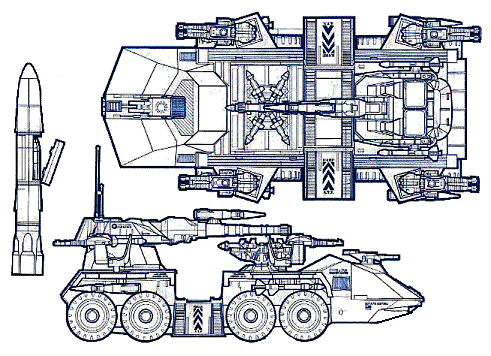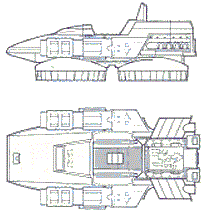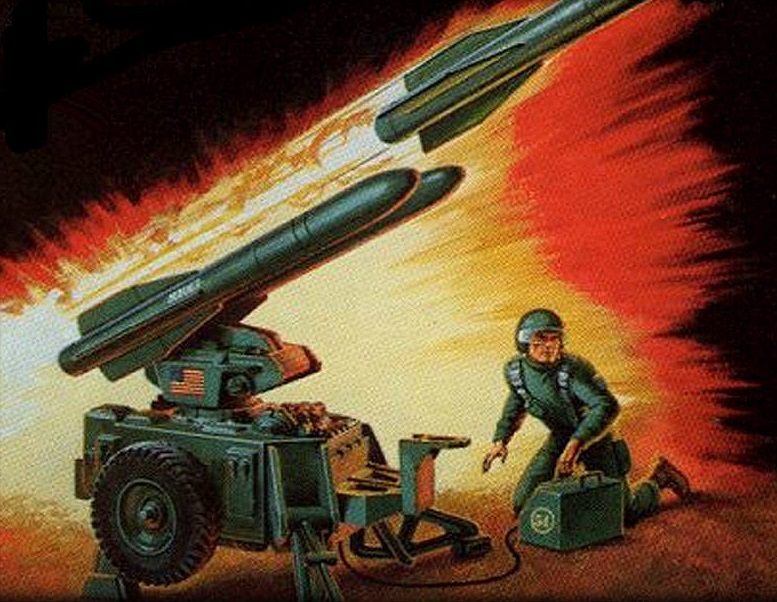
UGC Le L'egion 'Etrang'ere. | Tonnerre Roulant (Rolling Thunder) Mobile Missile Launcher System.
| 
UGC Le L'egion 'Etrang'ere. |
|---|
 | | Line Drawing of the Rolling Thunder Mobile Missile Launcher System and MM-3 Missile, |
|---|
 | | A Ravage Hoversled. |
|---|
The French Tonnerre Roulant ("Rolling Thunder") was developed in part from the Russian 9P129 6 by 6 wheeled Transporter Erector Launcher (TEL) sold by the US Army as "surplus" after the Iraqi Civil War (just prior to the Global Civil War). They were supported by a the GCR 331 Radar Array Assembly and RTR 43 Short Range Missile Launcher System, and could carry a small hoversled (designated the TTR-14 Ravage ("Havoc").The 9P129 TEL was originally intended to carry the 9K79 Tochka (SS-21 Scarab) ICBM; However, with the collapse of the Soviet Union in the late '80's, the Russians were forced to sell off most of them. They didn't ask who the buyer was all too often, and several ended up in the hands of rouge states and terrorists; Fortunately, the nuclear warheads they were intended to carry weren't, but the 9K79's themselves were.When the smoke and dust of the Iraq War settled, several of these ended up under Allied control.The French bought a few for research purposes, then reverse engineered them to develop a theater ballistic missile launcher platform; The Tochka's were cut-down to a Theater Ballistic Missile, weighing half as much and one quarter the width. This allowed the missiles to be double-loaded, without increasing the laden weight; In fact, the laden weight was still reduced, allowing a RM-4 Infantry Fighting Vehicle Turret to be installed. However, field testing revealed the 55MM Heavy Auto Cannons to be easily jammed and under powered; As a stop gap, the R-14 Howitzer was installed. Under equally arduous, indeed more so, conditions, the R-14's proved highly capable. The French Army decided to keep them.The addition of the three secondary missiles (turret mounted) were intended to dissuade fixed-wing aircraft, the six tertiary missiles (topside mounted, in the middle of the vehicle, on the turret) for low-flying aircraft (mostly helicopters). The four gun turrets were dual-purpose- Anti-aircraft and anti-infantry. Eight anti-armor missiles, mounted under the running boards proved a disappointment, since the whole vehicle had to be turned to fire the missiles into the right general area, but after firing they locked on fairly well. These were later replaced with wire guided missiles- These proved to be significantly more effective. The front mounted dual laser was added after full-fledged combat testing when the vehicle was successfully threatened with tactical rocket propelled grenades. The dual laser was equipped with a radar-targeting system; The Crew Commander (rarely more than major, more often a Captain) simply has to push the fire button. It can also be set to totally auto-fire.The addition of the hoversled, radar array, and missile turret (based loosely on the American Patriot Missile) were almost afterthoughts; Therefore they were never properly developed, and proved far less than what the French Army wanted.Stats for this vehicle are included because, unlike some other systems herein listed, the Tonnerre Roulant is still in service, usually with National Guard units. They still carry subordinate artillery arrangements, and in fact some units load normally trailer artillery onto the deck, tying them down; Though nominally frowned upon, it's not technically illegal.Major VariantsThere are only a few major variants, and all center around the MM-3 Theater Ballistic Missiles; Removing these opens up a huge bay and reduces weight. This space and weight is re-utilized with a large number of options.A (Alpha) Variant: Replaces the MM-3 with 20 Standard MRMs. The Erector must be removed.B (Bravo) Variant: Replaces the MM-3 with 60 standard SRMs.C (Charlie) Variant: Replaces the MM-3 with 200 standard Mini-missiles.D (Delta) Variant: A Medium-Range Transporter/Erector/Launcher And Radar (TELAR) array; About a dozen standard MRMs are integrated into the normal erector array, which angles fully erect to maintain standard observation, then when a suitable target is detected, angles down about 30 degrees to launch a missile; Once the missile is launched, the erector returns to the normal position while the Radar array continues to track the target until it is eliminated, then returns to sweeping the area.E (Echo) Variant: A Transporter/Erector/Launcher And Radar (TELAR) Variant. Once an appropriate threat is detected, the radar array is retracted, the main missile(s) fired, and then the radar array sung back into use to track the missile.Type: Land Based Missile Launcher (Theater Missile System; intended for nuclear weapons).Class: Transporter, Erector, Launcher, Tracker.Crew: 14;Crew Commander;Pilot: 2;Heavy Artillery Gunner: 2A/A Gunners: 4Support Craft Drivers: 1 or 2Missile specialists: 3Other Support Personnel: As many as 10 support personnel might deploy with a Tonnerre Roulant.MDC By Location: |
Hull-
Cockpit-
Main Turret-
Wheels (8)- | 150
50
50
50 | Engine Compartment-
Secondary Turrets (5)1-
Cross-Load Ramps (2)-
Main Missile Bay Hatches (2)- | 75
50
50 each
50 each |
1; Includes the 4 anti-aircraft gun turrets and the anit-aircraft missile turret.
Speed and Statistical Data: |
Top Speed: 30 knots.
Clearance: 30 feet with errector down, 50 feet errector up.
Beam: 30 feet.
Length: 25 feet.
Weight: 100 tons.
Cargo: Crew supplies only. | Cruise Range: Can operate up to 20 hours without support, but VERY rarely goes more than a few hours.
Power Plant: 2003 inch hydro-cell engines.
Propulsion: 8 wheels nominally; Can use grav pods and tractioning drive if absolutely necessry.
Flight System: Grav pods, but not intended to fly per se.
Cost and Availability: 6 million credits; Takes about 6 months to build.
Black Market Cost and Availability: Could be as little as 10% to 10 times as much, and fairly popular. |
| Weapons Systems: |
|---|
1. Dual MM-3 Theater Ballistic Missiles: Medium Range, heavy missiles. Also had 6 submunitions (equal to SRM's), designated DR-3's.
Purpose: Theater Control Missile; Mainly for destroying bases (can crush a few cities blocks).
MD:MM-3:DR-3:
Blast Radius:MM-3:DR-3:
Range: MM-3: DR-3: Can be dropped anywhere along the route; Goes about 1/2 mile from point of drop (usually a little right).
Rate of Fire: Both MM-3's can be fired together, but really not recommended, since it damages the frame. Can be fired ten minutes apart.
Payload: Just two.
MM-3 Theater Ballistic Missile

DR-3 Submunition.2. GCR 331 Radar Array Assembly: The GCR 331 Radar Array was developed in the very late 1980's as a field radar set. The program was fairly successful, and for the cost worked adequately.
Purpose: Tracking aircraft. Generally most effective against low-level aircraft.
Effect: 85% against low-level aircraft, 60% against high-level aircraft. 02% against stealth aircraft.
Range: Generally 2,000 miles. Not effected by weather.
Rate of Fire: Not applicable.
Payload: Not applicable.
 3. RTR 43 Short Range Missile Launcher System: Based loosely on the American Patriot Missile, with the blessing of the US Government, the RTR 43 were deployed with the Tonnerre Roulant to support anti-aircraft operations. 3. RTR 43 Short Range Missile Launcher System: Based loosely on the American Patriot Missile, with the blessing of the US Government, the RTR 43 were deployed with the Tonnerre Roulant to support anti-aircraft operations.
Purpose: Anti-Aircraft.
MD:
Blast Radius: 100 feet.
Range:
Rate of Fire: One missile per melee; Can only be fired singly.
Payload: Three missiles on the launcher.
4. R-14 Howitzer: A medium-weight howitzer installed after limited combat testing. Generally used against massed infatry formations and enemy bases. Can elevate to 60 degrees, can rotate a full 360 degrees.
Purpose: Anti-infantry/base.
MD:
Blast Radius: 100 feet.
Range: 10 miles, under optimal conditions.
Rate of Fire: Once per minute (4 melees).
Payload: 200 rounds; Take 20 minutes to completely replenish the magazine. | 5. Three Turret Mounted Medium-Range Missiles: Intended to dissuade fixed-wing aircraft. Based loosely on the Patriot Missile, though this time by means not approved of by the US Government; They were purchased through back-door procurement via Israel (one man was eventually hung for treason over this).
Purpose:
MD:
Blast Radius:
Rate of Fire:
Payload:
6. Six Topside Mounted Short Range Missiles: Intended to ward off low-flying aircraft, mostly helicopters. Not really 'missiles' per se, they're actually more like wire-guided rockets, and therefore have greater than average range and damage.
Purpose:
MD:
Blast Radius:
Range:
Rate of Fire:
Payload:
7. 4 Twin Anti-Aircraft/Infantry Gun Turrets: Four gun turrets arranged around the vehicle provide heavy anti-infantry and anti-aircraft defense. The turrets can be removed easily enough (takes 20 minutes, does not require tools).
Purpose:
MD:
Blast Radius:
Range:
Rate of Fire:
Payload:
8. Eight Anti-Armor Wire Guided Missiles: The vehicle must still be angled in the general direction of the target, but can work very well at up to 55 degrees when beyond 200 feet, which is perfectly workable, since under 200 feet the missile's warhead can not engage anyways.
Purpose: Anti-Armor.
MD:
Blast Radius: 100 feet.
Range:
Rate of Fire: One at a time.
Payload: 8 total.
9. Front Mounted Dual Laser: Intended for anti-missile defense. Works by melting the skin of the missile, then tears the guts apart; May cause the fuel tanks rupture, fuel explode, wire insulation to catch fire, the warhead to prematurely detonate, etc.
Purpose: Anti-Missile Defense.
MD: 1D4 times 10
Rate of Fire: 20 attacks per melee.
Range: 200 feet.
Payload: Unlimited.
|
| Weapons Systems: Le Legion Variant:Being legally a separate governmental body (a semi-autonomous territory of the Council), Le Legion is allowed to field certain ranges of equipment outside the UGC's normal supply channels; When they were integrated in the Plenipotentiary Council, they brough with them the Tonnerre Roulant's they had "inherited" from such French Regular Army as survived long enough to transfer them to the Legion. |
| R-14 Howitzer: Three Turret Mounted Medium-Range Missiles7. 4 Twin Anti-Aircraft/Infantry Gun Turrets:Altough the anti-aircrat turrets are still enplaved, they are now automated L-22 quad turrets. The gunners are no longer directly exposed, but rather in the main cabin manning control consoles.The change is highly controversial within Le Legion, as one gunner is now manning 2 stations, leading to information overload- The gunners simply can't keep up with trying to operatet 2 guns at the same time. Le Legiojn is attempting to reconcile this problem.Purpose:MD:Blast Radius:Range: Rate of Fire:Payload:The eight anti-armor wire guided missiles were removed and not replaced. Their utility was always debatable at best, and most users don't even bother maintaining the mounts.The front mounted dual laser has been replaced by a dual L-35. | UGC Critical Assessment:The REF (and the Army in particular) doesn't really "like" the new Legion Entrange variant, but acknowledges that "they made a fucking silk purse out of a sows ear by God damn."The Council itself will not provide funding ISO the new variant (nor any other), and only allows the use of Tonnerre Roulants ISO of operations beyond the UGC's allied support operations; In a particularly ugly incident, Le Legion listed Tonnerre Roulant's as "main battle tanks" and requested transport to an unaffiliated world on contract; A Patrol cutter, the SHARNHORST, delivered the shuttles to the deployment area, at which point then-Commander AhLIX Jphoess discovered what these "main battle tanks" were. Twelves years later, as an Admiral, he would testify that he was "angered beyond belief to have been duped" by La Legion. (La Legion has since apologized for the incident.) |
| Features: |
- AMC/FD (2): Anti-Missile Chaff/Flare Dispensers. Actually launches a glob of burning magnesium/aluminum alloy to confuse both radar AND heat sensory systems. Fires off 04 chaff/flares each time it is activated. The system is KNOWN to work on all KNOWN radar and infrared systems, but concerns continue that somewhere out there their MIGHT be a system that will be totally unaffected by the system. Reduce effects by 20% against smart missiles (add +20% to rolls for smart missiles.)
- Effect:
- 01-50 Enemy missile or missile volley detonates in chaff cloud- Missiles are all destroyed.
- 51-75 Enemy missile or missile volley loses track of real target and veers away in wrong direction (may lock onto another target).
- 76-00 No effect, missile is still on target.
- Also note that the chaff cloud will also blind nearby heat sensors (and optically based sensors at night) for 1 melee. They will suffer the following penalties: Reduce melee attacks/actions, and combat bonuses by half.
- Duration: 1D4 melee rounds.
- Payload: 120 chaff/flares. Each time the system is engaged, the system fires off 04 chaff/flares.
| - ESM: Radar Detector. Passively detects other radars being operated.
- Radar: See "GCR 331 Radar Array Assembly", above.
- HUD: Displays maps, radar, targeting information, and any OTHER information the crew member wants directly in front of them.
- Virtual Map: Displays a continuously-updating map of all bodies ahead for the pilot. Takes data from and gives data to other ships in the area. Effective navigation of 85% as updates come. Good to 500 miles. Specific range can be adjusted in 1 mile increments.
- Video Camera: Records from the HUD. 50 hours of recording available.
- Full range optic sensory suite: Infrared, ultra violet, Magnification, night sight, color filters, thermal imager. Range is about 200 miles for MOST sensors.
|
Combat Profile for Tonnerre Roulant Mobile Missile Launcher System:- The driver has 4 actions per melee, of which only ramming is aggressive; +2 dodge and parry, -6 ramming.
- The rest of the crew has their normal actions per melee EXCEPT the missile technicians; Erecting, Prepping, and launching the missiles takes a full 3 minutes (12 melees), during which they can only roll with impact, since their focus in on their missile launch preparations.
|







 3. RTR 43 Short Range Missile Launcher System: Based loosely on the American Patriot Missile, with the blessing of the US Government, the RTR 43 were deployed with the Tonnerre Roulant to support anti-aircraft operations.
3. RTR 43 Short Range Missile Launcher System: Based loosely on the American Patriot Missile, with the blessing of the US Government, the RTR 43 were deployed with the Tonnerre Roulant to support anti-aircraft operations.



